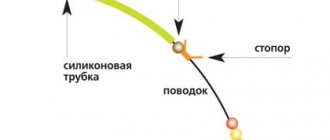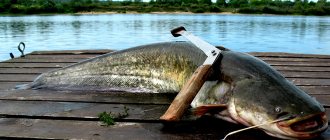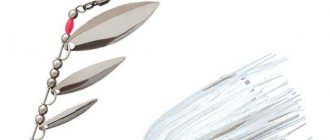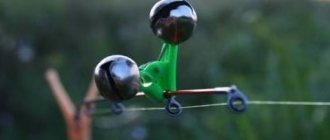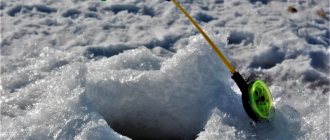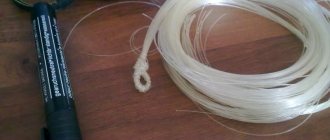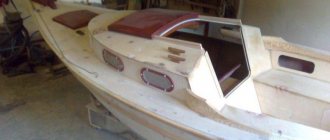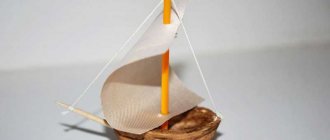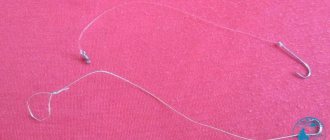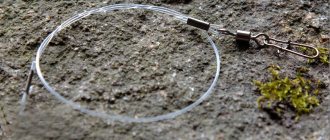The role of a leash when fishing
Artificial bait behaves differently depending on the situation.
- The bait moves separately , it interests the future victim.
- If the role of a leash is played by a thick string , then the bait loses its activity and attractiveness.
- The third option is a compromise . In this case, the leash is a thin hair, but its strength allows it to withstand heavy loads. Its plasticity is such that it allows the bait to make a variety of movements.
Steel leash
- VK
A leash in front of small wobblers was considered by spinning anglers to be a forced and not always desirable element. Nowadays it is not a problem to buy a ready-made metal leash for every taste and color. But as soon as it comes to miniature lures used in ultra-light spinning rods, the necessary leashes are not on sale, and those that are available are not suitable in length, diameter and fittings.
Leading materials are used in two types: flexible - cables and rigid, that is, just wire. In different situations and with different baits, both string and cable are used.
Hard leashes
When looking for material for a rigid leash, the first thing that comes to mind is string. In stores you need to ask for a guitar string “008”, that is, with a diameter of 0.08 inches, which in the metric system is equal to 0.2 mm.
Guitar strings are the most commonly used leash material.
What is striking is how much the cross-sectional area changes with a seemingly insignificant change in the diameter of the wire used. It turns out that string #1 is almost twice as light as string #2. And a leash made from wire with a diameter of 0.15 mm is generally four times lighter than one made from string No. 1.
The leash is made in the usual way. You just need to remember that as the diameter decreases, the mechanical properties of the twist change. It has been experimentally established that for wire of the same brand, as the diameter decreases, it is necessary to increase the number of twisting turns. So, for string No. 2 with a diameter of 0.4 mm, the minimum is 2.5 full turns when twisting, for string No. 1 with a diameter of 0.3 mm, 3.5 turns must be made, and for wire with a diameter of 0.2 - 5 turns. Problems arise with wire thinner than 0.2 mm.
The use of such thin wire implies a miniature leash. And with its length, say, 6 cm, two twists will take up half of the leash, which will undoubtedly make the finished product coarser and heavier. In addition, using such a twist to change bait is inconvenient. There is only one way out - to make the loops blind. Form a loop, wrap the short end of the wire around the leash seven to eight times with intervals between turns of 0.5 mm and solder it, since galvanized wire is easily soldered. If you do not solder, the loop does not unravel, but tightens.
Cable leash
If you cannot find such strings on sale, you can buy a steel cable at construction markets. A galvanized cable with a diameter of 1 mm is a flexible core consisting of seven straight wires entwined with 12 cores. Thus, by purchasing 1 m of cable, you will receive 7 m of high-quality and absolutely straight rope wire with a diameter of 0.2 mm. The cable unravels very easily - the main thing is to start correctly. At the beginning of the cable, it is necessary to take all 12 veins wrapping around the core to the side, and then, twisting the cable with the fingers of your right hand, divide it into two parts: the braid and the core.
The most difficult thing when making such leashes yourself is to find small-diameter crimp tubes on sale. Two years ago I managed to stock up on crimp tubes with an internal diameter of 0.4 mm and an external diameter of 0.8 mm, which are ideal for driving material of 0.18-0.19 mm. The leader material must be passed through the tube three times.
Squeeze the tube with small pliers with a little force so that the tube just crumples. If the cable crunches when compressed, such a connection should be rejected. The next crimp is done at an angle of 90°, and so on sequentially to the edge of the tube. The end of the tube should remain round. Four to five crimps are optimal. By the way, tube manufacturers do not particularly care that they are the same length. From different manufacturers, the length of tubes of the same diameter varies almost twice; very short ones are not suitable for the described crimping method.
For the industrial production of leashes, crimp tubes with a slightly larger diameter are used, this makes production easier. The leash I made from a material with a diameter of 0.19 mm with crimp tubes with an outer diameter of 0.8 mm has a mass of 0.0668 g, and a leash made from string No. 1 weighs 0.0879 g. I dare to assume that a purchased leash of the same diameter and length even without accessories, it will have the same mass as a leash made from string No. 1. So, the choice of cables for making leashes of considerable length is justified for two reasons. With a length of more than 10-15 cm, the softness of the leash becomes really noticeable, and as the length increases, the mass of the tubes is leveled out.
Wire leashes are the lightest and do not require a fastener to attach bait to them. But there is one point that negates the above advantages. You should tie a cord or fishing line to the leash loop only after testing it at home. Depending on the diameter of the leader, the connection point may be the weak link, since the thin wire cuts the knot under much less force than the breaking one. Then you will have to either select a knot (I recommend tying it with the end of the fishing line folded in half), or use the smallest clasp tied to the main fishing line.
When making wire leashes, you must also remember that thin wire is prone to breaking and forming so-called bugs, so the length of such leashes should be limited depending on the diameter: for example, from wire with a diameter of 0.2 mm, the length should be no more than 20 cm With a large length, it is very difficult to straighten the leash to an even state.
Related articles:
Installation of pass rings
Coloring artificial baits
Homemade feeder for feeder
Homemade jerkbaits
Characteristics of leader material for pike fishing
When choosing a material, you need to take into account the stiffness factor and the degree of visibility in the water.
- Kevlar. The material is characterized by its strength, but is soft enough to be invisible in water. Easily tied to fishing line. However, it is not difficult for the fish to snack on it.
- Titanium. This leash is a new product, but has a negative side in the form of its high cost. The material is clearly visible in water due to its shine. A pike, seeing such a bait, may not take it. The positive aspects include the long service life.
- Fluorocarbon. This is a soft material, completely invisible in water. When cast, it sinks very quickly. Fluorocarbon material has high plasticity, due to which fish are not able to break it. Disadvantage: it is easy to snack on. Fluorocarbon is not much different from fishing line, so if it is used, the thickness should be chosen up to 0.4 mm.
- Leash for pike fishing made of special material. Externally, these are threads made of thin steel, which are woven in the form of a pigtail, and on the outside there is a plastic shell. To attach it to the fishing line, it is additionally equipped with swivels and fasteners. Weight supported – 8 kg. And the length is around 30 centimeters. The material is soft, but the strength characteristics allow it to withstand the bite. There are also disadvantages, since it is visible in the water during fishing, becomes shaggy over time, and becomes twisted during fishing.
- Steel. Characterized by an increased degree of reliability. There were times, in the absence of such material, guitar strings were used as leashes for catching pike. It is impossible to bite through the leash, but it can withstand any weight. Disadvantages include its excellent visibility and clumsiness. The bait is constrained in its game.
- Tungsten. It has soft properties, with it the bait behaves independently. The disadvantages include its rapid failure during the fishing process, so it must be carefully inspected after each cast.
- Copper wire. It has the advantage of accessibility.
- Ordinary fishing line. It is available due to its low price. The fishing line has good tensile strength. Properties such as low abrasion, stretchability, good elasticity and invisible to fish in water give it good advantages.
We attach the wobbler to the fishing line through a leash
Of course, theoretically, the leash to some extent disrupts the balance and play of the wobbler. But which one? In each case, you need to look and draw conclusions. In addition, leashes are also different.
Standard leash
Such a flexible leash with a small swivel and a neat clasp is convenient in most cases, which is why it is used most often. The length of the leash depends on both the wobbler and the intended prey - usually 10-20 cm is enough. Pay special attention to the fastener lock - self-unfastening or forgetfulness lead to the unfortunate loss of both bait and fish.
String leash
A wobbler, unlike a spinner spoon, does not twist the line, so a swivel on a leash seems to be not necessary. Therefore, rigid leashes made of thin elastic wire (strings) are often used.
Such a leash may have a blind loop that twists behind a single bait, an unwinding loop and a special clasp. The last two options allow you to quickly change wobblers if necessary. Such lightweight leashes are usually used with small wobblers.
But a rigid leash can also be very useful when jerking a wobbler, when the bait moves in an active zigzag. A semi-soft leash here often gets caught in the hooks, but a hard wire leash - much less often.
rybalkaspinning.ru
It’s not difficult to choose material for leashes
Having given preference to any material, fishermen remain faithful to it for many years. Each of them has both positive and negative qualities:
- Thick or double monofilament line . Among the positive characteristics of leashes made of this material, one should highlight their availability and low cost. In addition, they are familiar and easy to manufacture in any conditions.
- However, their strength is questionable. In addition, the thickness of such a leash (at least 0.4 mm) completely unmasks the equipment.
- The main advantage of a fluorocarbon leader is its refractive index equal to that of water. It is practically invisible in water for fish. In terms of their performance characteristics, fluorocarbon leashes are close to the previous version of protection against pike teeth.
- One of the most popular leash materials. It is accessible, cheap and technologically advanced to manufacture. Its strength is beyond doubt.
- The most popular leash for pike fishing. It is plastic, soft and invisible in the water column due to its special coating. It has universal application depending on its load characteristics.
- has good strength and plastic characteristics. It is suitable for making leashes for spinning rods directly on the shore;
- The most successful option of all available. Leads made of this material fully comply with the previously described requirements for specific strength, ductility and camouflage qualities. The cost will not scare off even the most frugal people.
- Equipment using titanium leaders is good in all respects. She is durable, does not know fatigue and is not vindictive. Does not lose its strength even under repeated, maximum loads. Its weight is significantly less than the weight of all other equipment.
- First of all, due to its versatility. At equal weight, it is almost 5 times stronger than metal. This synthetic fiber has an elongation coefficient close to zero. At the same time, he is flexible and has no memory.
It should be recognized that steel leashes with 7x7 weave have optimal characteristics. The equipment made from them does not lead in any indicator, but in terms of their complex combination they have no competitors.
fishelovka.com
Tools for making a leash with your own hands
To make a leash for a pike with your own hands , you will need the following tools:
We also recommend reading:
How to properly tie a jig to a fishing line Diagram on how to learn how to tie a hook to a fishing line Tourist knots - types and methods of tying Gardner's loop for a feeder: how to tie
- Pliers with a side cut.
- Nippers with side cutting properties.
- Pliers with round jaws.
- Special pliers for fishermen that need to be used to open the winding rings.
- Diamond coated needle file set.
- Shoe's needle.
Making leashes for fishing with your own hands
Do-it-yourself fishing leashes are made in stages:
- Using side cutters, the driving material is cut to a size of 300 mm.
- Take a tube of the same size and, using a needle file, cut it and break it into two halves.
- Using a shoemaker's needle, the inner diameters of the tubes are flared.
- The resulting burrs are cleaned with a needle file.
- Insert the leash material into a tube and create loops on both sides.
- On one side of the tube there will be a leash and a small loop, and on the other there will be a loop with fittings in the form of a carbine attached to it.
- The tube must be carefully crimped with pliers.
- From the other end you should do exactly the same operation.
How to do it yourself?
Universal steel
You will need:
- stainless steel string;
- crimp tubes (in common parlance - “sleeves” - something like a metal cambric);
- carbine with swivel;
Manufacturing process:
- Take a 30 cm piece of string. A loop is made at its end, which is threaded “into the sleeve” and fixed by crimping.
- Another crimp tube is put on the other end of the future leash
- Then , the free end is threaded into the swivel of the carabiner and, folding it into a loop, inserted into the “sleeve” and crimped until it is completely fixed.
The result is a piece of steel wire with 2 strong loops at the ends, one of which has a carabiner attached. This is the leash. Its design is equal parts simple and reliable. It is truly universal and suitable for use on both spinning gear and float gear, or even mugs and girders at any time of the year.
A leash that is too long or too short can ruin your entire fishing trip. Depending on the circumstances, a carabiner with a swivel can be replaced with a jig hook or an ordinary tee.
Fluorocarbon
Fluorocarbon material is resistant when placed in an aggressive environment. This chemical polymer has found application in fishing due to its invisibility in the water. The fishing line made of fluorocarbon does not change its characteristics under the influence of the temperature field.
The fishing line does not stretch or fray, and quickly sinks in water. Considering its high cost, it is used only as a leash, and a regular fishing line is attached to it. The material has a complex production technology, which results in its high cost. A leash made of fluorocarbon fishing line can withstand up to twenty bites, so you should constantly monitor it during the fishing process. There are technologies for coating conventional fishing line with fluorocarbonate coating.
